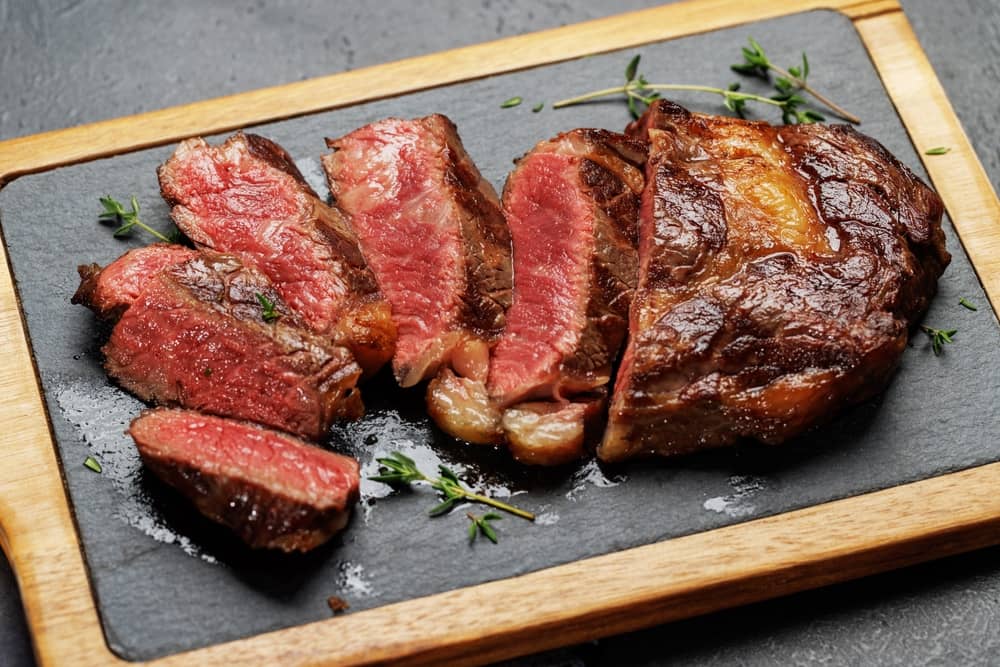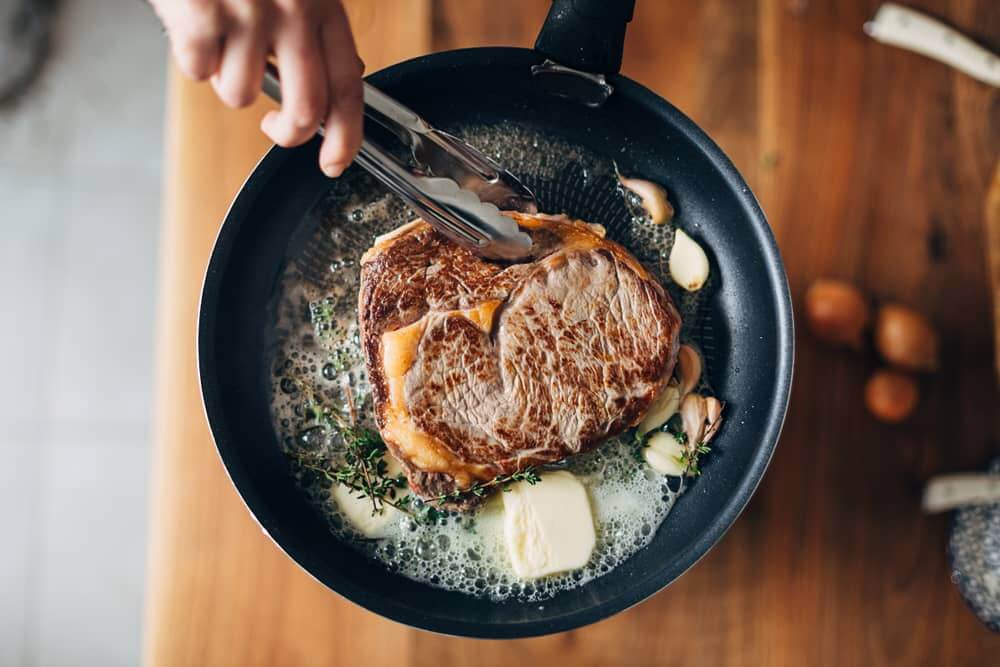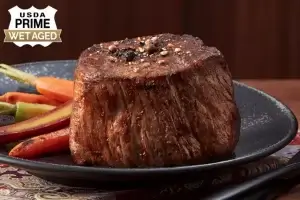
There are many ways to cook a steak. The reverse sear method is one of our favorites, but since you’re here, it’s probably one you don’t know much about. However, it’s a cooking method that we highly suggest you add to your arsenal, especially if you love medium-rare beef. This searing technique leaves a steak’s insides the perfect color of pink, while creating that brown, seared crust you crave.
Moooove over, other searing methods. This one may take a little longer to do than a regular sear, but it’s well worth the wait.
What is the Reverse Sear Method?
The reverse sear works the best on thicker steaks, like a filet mignon or tomahawk ribeye steak. In fact, you’ll most often hear of the reverse sear filet mignon or ribeye over other cuts.
As the name suggests, this searing method cooks your steak in reverse from the traditional way you’d sear. Instead of crisping up the outside edges first, and then finishing off cooking it to the proper temperature in the oven, you’ll do the cooking first and the searing second. The result is one incredible, fresh brown crust with just the right texture.
How Is Reverse Sear Steak Different from Sous Vide Steak?
Reverse searing often gets compared with the sous vide process of cooking a ribeye steak or another steak cut. While the idea is the same — more even cooking — it’s not the same method and doesn’t produce the same finished product.
Sous vide steak gets cooked in an airtight bag that’s placed in temperature-controlled water. The water helps the meat reach the proper temperature throughout, yet doesn’t dry it out at all because the water never touches the steak.
The reverse sear method is also used to achieve a more consistent cook, but it’s also designed to dry the steak out somewhat, allowing for that rich, crispy sear on the outside. Sous vide steak is usually left as-is after cooking rather than seared. Once a reverse sear steak gets cooked to the proper internal temperature, you sear it to get a browned crust.
What Type of Cuts Work Well with Reverse Searing?
Some of the most common cuts to use with the reverse sear steak method are thicker cuts that usually need more time to cook than others to cook to the proper temperature inside. Thicker steak cuts, like ribeye and filet mignon, are popular choices. But other thick steak options that work well with reverse searing include strip steak, tomahawk steak, and t-bone steak.
With that said, you can reverse sear just about any steak you love, whether it’s a sirloin steak on the grill or a skirt steak in a cast iron pan. You’ll just need to take more care not to overcook the steak in the beginning cooking phase when you aren’t using thick cut steak. And, thinner cuts generally don’t work as well.
Advantages of Reverse-Searing Ribeye
You might be wondering what benefits the reverse sear steak method has over other cooking methods for steak, like sous vide or regular searing. Here’s what reverse-searing does for ribeye.
More Even Cooking
A significant reason some people prefer to reverse sear a steak over cooking it other ways is to get a more even cook from the inside to the outside. This is especially true if you don’t like a lot of pink in the center. It can be difficult to achieve a medium or even medium-rare level of doneness with the traditional cooking method of a very thick steak, but it’s easily achievable with the reverse sear method.
Better Browning
Another reason the reverse sear steak method can get you a perfect steak is the science that goes on behind the scenes. When you cook the steak for a few minutes before searing it, it allows the surface moisture to evaporate from the steak. Then, when your steak is ready to become a seared steak, you won’t have moisture standing in the way of getting that perfect sear, yet you’ll still have a juicy steak inside.
More Tender Meat
Reverse-searing helps preserve the ribeye’s natural juices, giving you that rich, melt-in-your-mouth tenderness you want when you eat ribeye. Because the steak cooks slowly at a low temperature first, it doesn’t tighten up the muscle fibers the way high heat can. That gentler cook means less moisture loss, so your ribeye stays juicy throughout and tender from edge to center, even after that final hot sear locks in the flavor.
More Flexibility
One of the best parts of the reverse sear method is how forgiving it is. The slow-and-steady cooking phase gives you more control over the doneness, so you’re not scrambling to hit the perfect temp in a hot pan or on a grill. It’s also great when you’re cooking for a crowd. Just pre-cook the steaks to temp, set them aside, and sear them off one at a time when you’re ready to serve.
Disadvantages of Reverse-Searing Ribeye
The reverse sear method is great for many of the most popular, thicker steak cuts, but it’s not the right choice for all steaks. One of the biggest disadvantages of the reverse sear is that it isn’t a good option for thin steaks. Thin steaks often cook so quickly, regardless of what method you use, that trying a reverse sear might actually lead to an overcooked steak.
Another disadvantage is that this method can take a little more time to sear the steak. If you’re short on time or just want the quickest cook possible, sticking your steak on a cast iron pan or the grill and searing it can be quicker. However, if you have a thick cut that will need a few minutes in the oven anyway after you sear it, the timing will be about the same.
Finally, a pan sauce isn’t as easy to make with a reverse sear. Unlike regular searing, reverse searing won’t leave behind those yummy brown and crispy bits in your pan that are often used to make a pan sauce with butter and spices.
Reverse-Searing Tips and Tricks
Reverse searing can feel like a bit of extra work, but a few insider tricks will make the process smoother and deliver even better results. Here are some tips to elevate your next reverse-seared ribeye:
- Take your steaks out of the fridge 30-45 minutes before cooking to help them heat through evenly and reduce oven time.
- Dry each side of the steak with paper towels before seasoning to help the surface sear faster and more evenly.
- Rather than guessing, insert a thermometer probe into the thickest part of the steak for precise doneness and consistent results every time.
- Let your cast-iron or stainless pan get smoking hot before adding oil or butter, which guarantees a sharp, golden crust.
- Toss in a pat of butter with a smashed garlic clove and fresh thyme right at sear time, and spoon the melted herb-butter over the steak for extra flavor and juiciness.
- Add a light sprinkle of flaky sea salt right before serving for a final punch of taste and texture.
How to Reverse Sear Ribeye Steak

Ingredients
- Ribeye steaks
- Kosher salt
- Freshly ground black pepper
- Steak seasoning or dry rub (optional)
- Butter or high–smoke–point oil, like canola or vegetable oil)
Instructions
- Preheat the oven to 275-degrees.
- Season your ribeye steaks with salt and pepper or your favorite seasonings or rub.
- Place the ribeyes on a metal rack on top of a baking tray.
- Cook the steaks to about 110-degrees for a medium-rare cook. Use a meat thermometer to check the internal temperature. Depending on thickness, this could take anywhere from 30 to 60 minutes.
- Remove the meat from the oven and allow it to rest away from heat for ten minutes.
- While the steaks rest, warm up your skillet over high heat.
- Once the pan is hot and the ribeyes have rested, add a small amount of butter or oil to the skillet.
- Add the steaks to the skillet and allow the bottom side to brown up. This should take between 45 and 75 seconds.
- Flip the steaks and do the same to the other side.
- Once both sides are browned, turn the steaks on their sides to allow the edges to brown up.
- Enjoy!
Notes
You can use a similar method on the grill too. Cook the steaks over low heat until they’re about 10-degrees below your optimal cooking temperature. Then move them over to the side with high heat and give them a good sear on each side.
Reverse Seared Ribeye Steak – Nutritional Facts
Per Serving (based on 2 servings, based on a 2,000-calorie daily diet)
| Nutrient | Amount (% Daily Value (DV)) |
|---|---|
| Calories | 630 (32%) |
| Total Fat | 46g (59%) |
| Saturated Fat | 17g (85%) |
| Trans Fat | 2g |
| Cholesterol | 135mg (45%) |
| Sodium | 580mg (25%) |
| Total Carbohydrate | 1g (0%) |
| Dietary Fiber | 0g (0%) |
| Total Sugars | 0g |
| Added Sugars | 0g (0%) |
| Protein | 47g (94%) |
| Vitamin D | 0.3mcg (2%) |
| Calcium | 24mg (2%) |
| Iron | 4.0mg (22%) |
| Potassium | 640mg (14%) |
Does the Reverse Sear Method Change for Different Cuts?
This method won’t change much for most cuts other than filet mignon or ribeye. The only thing you’ll have to play around with is the amount of time you keep your steaks in the oven and the amount of time each side needs to brown in the skillet. The thicker the steaks, the longer it will take in the oven to reach the proper internal temperature.
Conclusion: Reverse Seared Steak
Now you know how to reverse sear your steaks for the best crispy crust around! This method is one you can even use with other meats, like pork and chicken, or even your favorite vegetables (they’re fantastic on the grill!). Check out some of the meats you can order online from Chicago Steak Company to get shipped right to your door. Use this guide to sear them to perfection, and check out Steak University for some of our other favorite cooking techniques.
Reverse Searing FAQs
Reverse Seared Ribeye Steak
Equipment
- Oven
- Stove top
- Cast Iron Skillet
Ingredients
- 2 8 oz Ribeye steaks
- 1 oz Extra virgin olive oil
- Chicago Steak Company Seasoning
- .5 oz Worcestershire sauce
Instructions
- Preheat the oven to 275 degrees.
- Season both sides of the ribeye steaks with Chicago Steak Company seasoning and Worcestershire sauce. Lightly press seasoning into steak.
- Place steaks on a metal rack on top of a baking tray and put into the oven.
- Cook until steaks reach an internal temperature of 110-degress for a medium rare doneness. Depending on the thickness of the ribeye it can take between 30-60 minutes.
- Remove meat from the oven and let rest for 5-10 minutes to allow the juices to disperse throughout the steak.
- Add EVOO olive oil to your cast iron skillet and heat up on the stove top. Wait until the oil is scalding hot before adding the steaks.
- Add the ribeyes to the skillet and allow the bottom side to brown up. This should take between 45 and 75 seconds. Flip the steaks and do the same to the other side.
- Once both sides are browned, turn the steaks on their sides to allow the edges to brown up.



